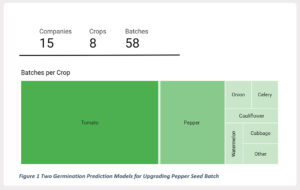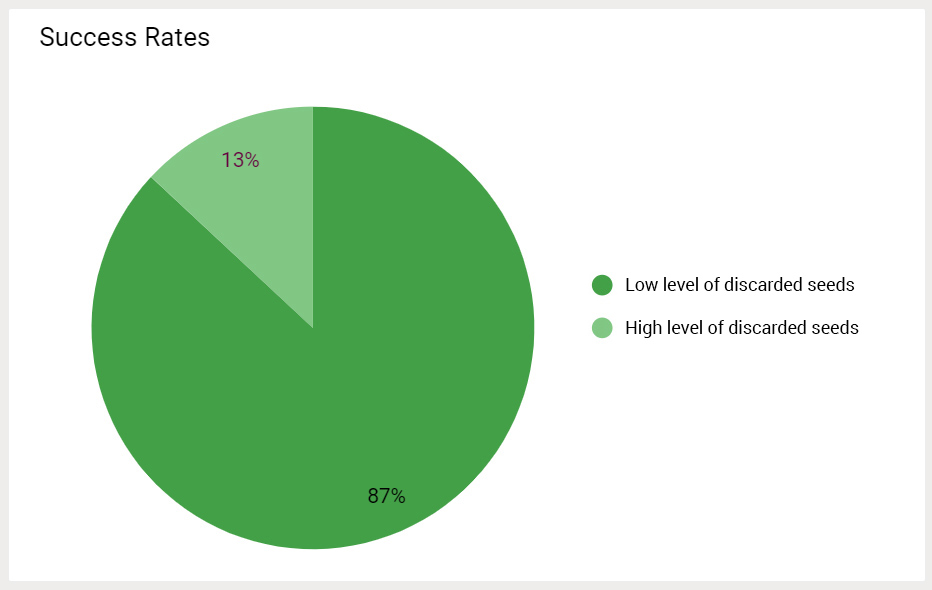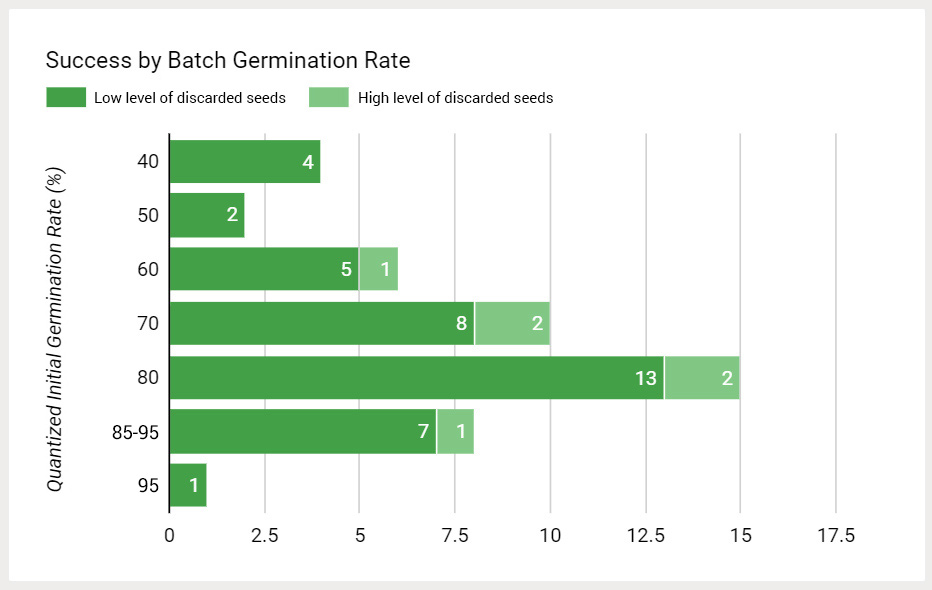Executive Summary
Today, even with well-established seed production processes, seed germination rates often fail to meet the minimum germination gold-standard of 90%, resulting in batch disqualification and economic loss. Seed-X has proven it can effectively turn non-sellable into sellable batches. In a series of recent experiments in Europe, Israel and the US, on 8 crop types, including Tomato and Pepper seeds, Seed-X’s GeNee™ technology was successfully trained to distinguish between germinating and non-germinating seeds. In 58 experiments, Seed-X’s GeNee™ technology achieved germination rates over 90%, in batches with germination levels ranging from 40% to 85%. In a high majority of experiments, the 90% germination rate was achieved with minimal levels of discarded seeds. Seed-X’s GeNeeTM technology applies computer vision and artificial intelligence to overcome current seed germination shortcomings. The system can be trained to enhance accuracy over time. This technology will soon be available in Seed-X’s revolutionary AI-powered seed sorter.
Seed-X Germination Prediction Dashboard: An overview of Seed-X’s generalized seed germination prediction technology
Background
Unpredictable seed germination is a challenge for the entire seed industry. Investing in seeds that fail to germinate and plants that are unusable translates into considerable economic and yield losses.
Seed-X’s GeNeeTM technology applies computer vision and artificial intelligence to overcome current seed germination shortcomings, setting a new germination standard for the seed industry.
Working in collaboration with leading seed companies, Seed-X has developed an AI-powered seed germination prediction tool which has already been successfully applied to dozens of seed batches of several crops, with various germination rates. This technology, which uses computational image analysis and deep learning to distinguish between phenotypic groups, will be integrated into
Seed-X’s GeNee Sorter™ machine, enabling seed sorting on the basis of proper germination, in addition to other seed attributes.
We are happy to share our germination dashboard showing the overall amount of germination experiments Seed-X has conducted over the last few months.
Highlights:
- 58 experiments conducted on 8 different crops prove our technology has the capability to upgrade the germination ratio in different crops.
- Due to customer requests, more effort was placed on Tomato and Pepper seeds (hence the focus on these crops in this study).
- 46 experiments were conducted with Tomato and Pepper seeds on batches with germination rates ranging from 40% to 85%.
- In all 46 experiments, we managed to upgrade the batch to over 90% germination. In 40 of these, we reached over 90% germination ratio, while discarding between 5% – 25% of germinating seeds.
Figure Legends:
Header – Dashboard figures are based on data collected and analyzed during 2020.
58 seed batches, belonging to 8 different crops were provided by 15 leading seed companies.
Batches per Crop – In the trial, most attention was given to Tomato (31 batches) and Pepper (15 batches), due to their high seed price and, respectively, the interest shown by seed companies. In our trials, Tomato and Pepper were represented by different varieties and lots, repeatedly found amenable for germination prediction. Other crop seeds successfully predicted for germination were: Watermelon (2), Cabbage (2), Cauliflower (2), Onion (2), Celery (2) and two undisclosed crops, underlying technology robustness across a broad crop taxonomy.
Seeds per Location – Seed imaging and germination testing was conducted in Israel, Europe and in the USA, using Seed-X’s GeNee Detect™ devices. Bubble diameter is proportional to geographic seed batch distribution.
Success Rates – Germination prediction process and output is illustrated by the 46 Tomato and Pepper batches that comprise most of our batch collection. Each batch was assayed independently. Following algorithm training and phenotypical observation, an experiment was deemed successful if prediction output resulted in at least 90% germination rates. Incredibly, this was the case for ALL the experiments. Predictions were further segmented based on germinating seed loss rate, indicating the proportion of false-negative incidents. 87% percent of all experiments exhibited minimal levels of discarded seeds up to 25%, while 13% exhibited higher levels of discarded seeds. The amount of discarded seeds may be reduced to lower rates by expanding the training to enable the classifier to better discern between the germinating & non-germinating seeds.
Success by Batch Germination Rate – Success rates distributed across the original germination rates of the 46 Tomato and Pepper batches. Classification was proven successful across a broad distribution of germination rates, with high seed recovery already achieved with batches of extremely poor quality as low as 40% germination.
Conclusion
In 58 recent experiments, Seed-X’s GeNeeTM technology has proven its ability to dramatically enrich seed batches of several crops with various germination rates to 90% (see table below). In most cases, especially for germination rates relevant to the seed industry (>70%), such enrichment also recovers most of the germinating seeds, leading to minimal levels of discarded seeds. Sub-optimal recovery rates can be further improved by augmenting the training set with additional examples of germinating and non-germinating seeds better covering seed variance, and better underpinning the differences between those groups.
Representative germination predictions generated in Israel, Europe or in the US with different crops:
Seed-X’s seed germination prediction technology will become commercially available in mid-2021, embedded within the GeNee Sorter™.
For additional information, please visit our website at: www.seed-x.com or contact us at: info@seed-x.com.





